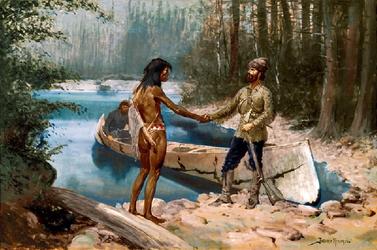
Their English counterparts on Hudson Bay would have been called "woods-runners", and to the Anglo-Dutch of Albany they'd have been known as "bush-lopers". What was common between all of them was that they were drawn into the independent fur trade by the lure of adventure, freedom, and money.
 |
| A coureur des bois in the painting, La Vérendrye at the Lake of the Woods, circa 1900-1930 by Arthur H. Hider (1870-1952) |
Note: The name Coureurs Des Bois is occasionally interchanged with that of the voyageurs, but while some coureurs des bois may have been enlisted as voyageurs, in fact, the coureurs des bois predated the influx of the voyaguers who were the canoe travelers hired to work for the big fur companies like the North West Company, the Hudson's Bay Company, the XY Company, or the American Fur Company.
While licensed fur traders had the blessing of the government and the fur companies, the coureurs des bois were unlicensed to trade, though trade they did. That's right. They were the rebels of the forest.
The French King, in an attempt to regulate trade, had created laws which forbade anyone to go into Indian country to trade except those of the monopoly company. Licenses were granted, but only to a select few. The government preferred the native population to bring their furs directly to French merchants. But as population increased, more and more young men looked to the fur trade for their living, and with only minimal licenses being issued, that meant they had no choice but to work independently. Young men began deserting their assigned seignories (farms) in New France and escaped to the wilderness, drawn by the prospect of fortune as well as the lure of an unstructured life in the Indian villages. It has been estimated that, by the end of the seventeenth century, possibly as may as one-third of able-bodied men had chosen the life of the coureur des bois, choosing to break the law and escape to the wilderness to trade for furs themselves. Once they had a taste of the free-roving, adventurous life of the coureur des bois, they seldom returned to the colonies or their farms, even though the punishment, if caught, would be severe.
These independent traders thought that operating outside government regulation a risk worth taking and a life worth living. They genuinely enjoyed the camaraderie of the First Nations people with whom they often settled and raised families, and they became fluent negotiators and adept guides.
You might think that since the coureurs des bois did their work illicitly, colonists would refuse to trade with them. However, not only did the colonists trade with them, when times were tough, colonists often took part in the trade and became coureurs des bois themselves.
You may recall in my article last month, I wrote of the explorer Du Luth, who belatedly recalled that'd he'd gone on his adventure without the proper license, and made a hurried attempt to remedy the situation by claiming all the land he explored for the King of France. There were some other famous explorers who began as coureur des bois as well. Here are several of the most notable:
- Radisson and Groseilliers were brothers and coureurs des bois credited with establishing the Hudson Bay Company.
- Étienne Brulé was the first European to see the Great Lakes.
- Jean Nicolet explored the region around Green Bay and established peace with the Indians there.
| Etienne Brulé |
Imagining the adventure~
Naomi Musch
https://naomimusch.com/

This is pretty new to me, I admit. I thought all fur traders were French!
ReplyDeleteOH. and PS! Congratulations on your Selah final!
ReplyDeleteThank you! I'm pretty elated. :)
DeleteExciting times!
ReplyDeleteExciting, yes! I think every generation has that breed of people who want to set out into the unknown and do the hard things.
Delete